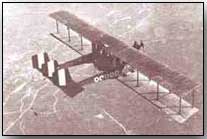Other Comments:
The War in the Air - Bombers: Italy
 The frontier between Italy and Austria was different to any other frontier in the First World War. To the north the Alps protected the Austrian heartland. To the east the Austrian navy sat just across the Adriatic: its chief port was at Pola and it had major ship-building yards at Trieste. The frontier between Italy and Austria was different to any other frontier in the First World War. To the north the Alps protected the Austrian heartland. To the east the Austrian navy sat just across the Adriatic: its chief port was at Pola and it had major ship-building yards at Trieste.
The Italians controlled the air throughout almost the entire war, and waged an innovative and aggressive air campaign. It was the only county other than Germany to use lighter-than-air craft for bombing purposes. The Italian airships were "semi-rigid dirigibles," they were different to the "rigid" Zeppelins in that they had a keel only, as opposed to an entire frame as favoured by the Germans.
Their first bombing raid was on the 26th of May, 1915, three days after entering the war, when they crossed the Adriatic to attack Sebenico, which was attacked by a dirigible again the following day.
The airships were used throughout the war, attacking railway yards and enemy encampments and the naval base at Pola. By the end of the war they had 20 dirigibles. Their 'M' class airships could carry a 1,000 kg (2200lb) bomb load and reach an altitude of 15,000 feet.
They were not however immune to attack. On the 8th of July 1915 the Citta di Ferrara was shot down by an Austrian seaplane, and on the 5th of August the Citta di Jesi was lost to anti-aircraft fire. Austrian seaplanes bombed the Italian airships at their bases in Jesi and Ferrara.
As opposed to Germany, Italy did not base its major bombing campaigns on the airship. From the opening days of the war the Corpo Aeronautico Militare, CAM, made use of the Caproni bomber designed by Gianni Caproni. The CA32 series of bombers were powered by three inline engines: two tractors located in the wings, and one pusher at the rear of the central nacelle.
These planes could carry a crew of three and a load of about 450kg (1,000 lb). The three engine design not only provided great lifting power, it also provided safety as the Caproni could remain aloft with only two engines running. In addition to his design work, Caproni also produced a number of papers discussing the rationale and technique for bombing operations, urging the Italian government to pursue a strategic campaign against transport and industrial targets.
The first Caproni bombing sortie was on the 20th of August 1915, against the Aisovizza aerodrome, dropping explosives and incendiaries. By October they had four bomber squadrons, and by early 1916 CAM was operating seven bomber squadrons.
In February they made their first long distance bombing raid, against Ljubljana, in reprisal for an Austrian attack on Milan. In September they made a 22 plane raid across the Gulf of Vienna to bomb the arsenal and seaplane base at Trieste. No less than 540 bombing sorties were flown in 1916 alone, and by early 1917 the Italians were regularly flying missions comprising upward of thirty bombers on both day and night missions.
In 1917 the Italians made large use of the Caproni in direct support of the troops. At the tenth battle of Isonzo they began the offensive with two waves numbering over sixty aircraft each. At the eleventh battle of Isonzo they began with an attack of 145 aircraft, and flew well over 200 hundred sorties a day.
Towards the end of 1917 the United States sent a detachment of five hundred men to be taught military flying. After their training most of them were sent to France, but a detachment of about 75 remained in Italy, under the command of Captain Fiorello La Guardia, future mayor of New York, where they flew missions within the overall framework of CAM. These were the first ever bombing missions carried out by Americans.
In addition to tactical bombing, the Caproni bombers continued their strategic campaign. In particular they targeted Pola, the shipyards of Trieste and the Whitehead torpedo factory at Fiume, sometimes massing over 100 aircraft for a single raid. This campaign continued right through to the end of the war.
In 1918 Caproni produced a small number of CA 42 bombers. This was the only triplane bomber used in the war, and it made its debut at the last great battle on the Italian front, the battle of Vittorio Veneto. It was more heavily armed than its predecessors, and could deliver a 1,450 kg (3,197 lb) bomb load.
The RNAS took delivery of a flight of six of these aircraft, and the US Navy contracted to have them built under license in the United States. None of these US built bombers made it to Europe in time for the fighting. Italy built about 250 CA32s and about 30 CA42s.
Article contributed by Ari Unikoski
http://www.firstworldwar.com/airwar/bombers_italy.htm
|


